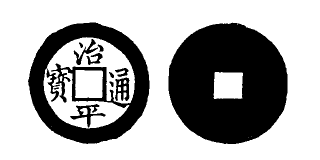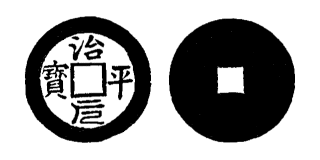Coins and Banknotes of Vietnam
and French Indochina
XII. The 李 Ly Dynasty. - 1010-1225.
Another general of the palace, LY CONG-UN, proclaimed himself king, and was afterwards known by the name of 太祖 THAI-TO. At this time the kingdom of Annam became known by the name of 交趾 Giao-chi, given by the Chinese Emperors; and the capital was established in 河內 Ha-noi. Thai-to found the necessary elements for the consolidation of the royal authority, and made good use of them, giving birth to the first of the three great dynasties which ruled Annam prior to the present century. During his reign regular taxation was established upon fisheries and agriculture, such taxes being paid in rice and cash. The civil administration and the army were also re-organized; and for the first time the king received solemn investiture from the Emperor of China, thus admitting the right of sovereignty which the Chinese Empire pretends to hold over Annam. It is from this time that the Chinese claimed tribute, and later on, to enforce those claims, their armies invaded and occupied the country.
Thai-to was succeeded in 1028 by his son 太宗 THAI-TONG, who during his reign of twenty-eight years had to fight, only against the rebels who rose in arms in the frontier provinces. In 1036, having restored peace on the frontiers of China, he received from the Emperor the title of 南平王 Nam-binh-vuong The most important of these rebellions was that under 治高 Tri-cao who, defeated in 1050, revolted again in 1052, invaded the Chinese provinces of 廣東 Kuang-tung and 廣西 Kuang-si, and with the Annamese province of 廣原 Quang-nguyen founded the kingdom called 大南 DAI-NAM, in which he was proclaimed king by his followers under the name of 仁惠 NHON-HUE. In the early days of his reign success attended him, and he defeated the various Chinese armies sent against him; but finally he was beaten, and his kingdom disappeared with him in 1054.
During the reign of Thai-tong, Buddhism made great progress in Annam, the king ordering in 1031 the construc-tion of nearly one thousand monasteries.
In 1055 聖宗, THANH-TONG, son of Thai-tong, came to power, and his first act was to change the name of the kingdom to that of 大越 Dai-viet, used during the DINH Dynasty. His reign was peaceful, and in 1072 he was succeeded by his son 仁宗 NHON-TONG, notorious for his wars against the Chinese. The Emperor 真宗 CHlN-TSUNG of the Northern 宋 Sung Dynasty had decided to conquer Annam, and to that end he sent a numerous army, which, however, did not pass the 廣原 Quang-nguyen frontiers. The army was detained for several months on these frontiers, and suffered great loss in every engagement it had with the Annamese, till at length peace was signed, and the invaders returned to their own country.
神宗 THAN-TONG, a nephew of the last king, occupied the throne in 1128, and reigned until 1139; the only notice taken of him in the Annals was that he was mad. He was succeeded at his death by his son 英宗 ANH-TONG, during whose reign the port of Hai-phong was opened to trade with Siam, the Malay Peninsula, and Burmah. In 1142 a bonze called 晋利 THAN-LOI raised a rebellion, and was proclaimed king under the name of 平王 BINH-VUONG. He was, at first, successful, collected numerous forces, and went to besiege the capital; but, routed on the way to Hanoi, he sought refuge in the mountains of Tunquin, where he was made a prisoner, taken to the capital, and decapitated.
In 1176 高宗 CAO-TONG, son of Anh-tong, came to power, and ten years afterwards he received his investiture from the Emperor of China, being called for the first time 安南王 An-nam Vuong, or King of Annum. He was corrupt and addicted to vice, and was dethroned by a military rebellion in 1211. His son 惠宗 HUE-TONG, supported by his father-in-law 陳李 TRAN-LY, succeeded to the throne. The kingdom was in a very disturbed state: the 李 Ly Dynasty had already lost the prestige acquired by its first kings, and the fear of imaginary or real dangers which surrounded the life of the king made him lose his reason and his throne. He became mad and abdicated in 1225 in favour of his daughter 昭感 CHIEU-THANH. The 陳 TRAN family did not lose such a good opportunity to obtain the crown; one of its members 陳景 TRAN-CANH married the queen, and, on her abdicating in favour of her husband, the Ly family, the true founders of the Annamese kingdom, disappeared from power.
No. 5. (Barker: see 3.1-3.2)
Obverse: 順天大寶 Thuan-thien-dai-bao.
Reverse: plain. Coin issued during the reign of 太祖 THAI-TO, the first king of this dynasty, (1010 to 1028). The two following kings issued no coins.
No. 6. (Barker: 4.1)
Obverse: 乾符元寶 Can-phu-nguyen-bao.
Reverse: plain. This coin was issued during the reign of the Emperor 太宗 THAI-TONG. (1028-1055.) It was during this epoch that the use of small thin cash was first introduced, on account of the great scarcity of copper then existing in the kingdom. The Chinese traders immediately took advantage of this circum-stance, and had Chinese cash recast into smaller ones, exporting them from their own country into Annam. In consequence of the abundance of coins caused by this proceeding the manufacture of cash was suspended by the Annamese govern-ment for a period of fifty years.
No. 7. (Barker: none)
Obverse: 天符元寶 Thien-phu-nguyen-bao.
Reverse: plain. Diminutive coin made during the reign of the Emperor 仁宗 NHON-TONG in his seventh nien-hao. It is of white copper, and the character 元 Nguyen of the obverse is written in seal characters
No. 8. (Barker: 116.1)
Obverse: 大定通寶 Dai-dinh-thong-bao.
Reverse: plain.
No. 9. (Barker: see 116.1)
Obverse: Same as No. 8.
No rim on the Reverse.
No. 10. (Barker: none)
Obverse: Same as No. 8, but varying in the distribution of the four characters.
Reverse: plain. Diminutive coins made during the reign of King 英宗 ANH-TONG (1139-1176), during his second nien-hao.
No. 11. (Barker: none)
Obverse: 天感通寶 Thien-cam-thong-bao.
Reverse: plain. Diminutive coin made during the reign of the same king in his fourth nien-hao.
No. 12. (Barker: none)
Obverse: 天資通寶 Thien-tu-thong-bao.
Plain Reverse. Diminutive coin issued by the King 高宗 CAO-TONG (1176-1211), in his second nien-hao.
No. 13. (Barker: none)
Obverse: 治平通寶 Tri-binh-thong-bao.
Reverse: without rim.
Nos. 14 and 15. (Barker: 8.2)
Obverse: 治平元寶 Tri-binh-nguyen-bao. The character 元 nguyen is written in two different forms of the tchuen or seal characters.
Reverse: No. 14 plain; No. 15 without rim. Diminutive coins issued by the former king in his fourth nien-hao.










